History of Block Printing in India
Records show that as far back as the 12th century, several centers in the south, on the western and eastern coasts of India became renowned for their excellent printed cotton. On the southeastern coast the brush or kalam (pen) was used, and the resist applied by the same method. In the medieval age printing and dyeing of cottons was specially developed in Rajasthan. In Gujarat the use of wooden blocks for printing was more common.
Tents were made from printed fabrics and soon they became necessary part of royal processions. The seasons largely influenced the integration of the highly creative processes of weaving, spinning, dyeing and printing. Festivals also dictated this activity. Block printing is a special form of printing first developed in China. The earliest known example with an actual date is a copy of the Diamond Sutra from 868 A.D (currently in the British Museum), though the practice of block printing is probably about two thousand years old
Trade in cotton cloth is said to have existed between India and Babylon from Buddha's time. Printed and woven cloths traveled to Indonesia, Malaya and the Far East. In the 17th century, Surat was established as a prominent center for export of painted and printed calicos, covering an extensive range in quality. Cheaper printed cloth came from Ahmedabad and other centers, and strangely enough Sanganer was not such a famous center for printing as it is today.
Printing process
The first step in block printing is the production of the original document. This is laid on a large, smooth wooden block and fixed into place, reversed. Next, craftsmen of various skill levels, ranging from master carvers for the fine work to less talented artisans for cheaper blocks or less important sections, carve the original painted, drawn or written image into the block of wood. The block can now be covered with ink and used in a press to create duplicates of the original.
In some ways block printing is superior to cast type or moveable type -- for a language such as Chinese which has a very broad character set, block prints are much cheaper to produce for the initial run. The process also allows greater artistic freedom, such as the easy inclusion of pictures and diagrams. However, printing blocks are not very durable, and deteriorate very rapidly with use, requiring constant replacement that limits the possibility of large-scale print runs. Printing blocks can, however, be made from a variety of materials such as wood, linoleum, rubber, or even potatoes.
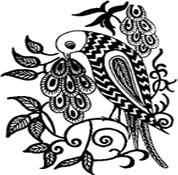

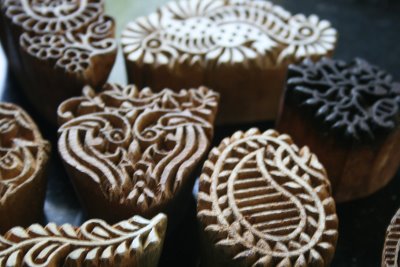
Block Printing in Gujarat
In Gujarat, this form of hand Printing has been practiced and perpetuated by the Paithapur families. They make intricate blocks, and print their textiles using the mud resist-Printing method. These prints are called Sodagiri (trader) prints. In Kutch, the popular patterns are black and red designs of birds, animals, and dancing girls. The saris of Ahmedabad and Baroda have large mango patterns against a red or blue background. The other well known centers for block Printing in Gujarat are Bhavnagar, Vasna, Rajkot, Jamnagar, Jetpur and Porbandar. Dhamadka a village in Gujarat has many printers using mostly madder root for printing red color, rusty iron solution for black color and indigo for blue color. These fabrics are known as Ajrakh. The designs made by block printing are geometric. Many states have block-printing workshops using chemical dyes. However there are only small pockets of areas still using natural dyeing with age-old recipes and local plant material.

Block Printing in Rajasthan
From Gujarat, the art of block Printing spread to Rajasthan. Here colorful prints of birds, animals, human figures, gods and goddesses are popular. The important centers are Jaipur, Bangru, Sanganer,Pali and Barmer.
Sanganer is famous for its Calico printed bed covers, quilts and saris. In form of hand Printing are Calico Printing, the outlines are first printed, and then the color is filled in. Bold patterns and colors are popular. They are printed repeatedly in diagonal rows. Doo Rookhi Printing is also famous here. In this technique, artists print on both sides of the cloth.
Bagru is famous for its Syahi-Begar prints and Dabu prints. The former are designs in a combination of black and yellow ochre or cream. The latter are prints in which portions are hidden from the dye by applying a resist paste.
Barmer is known for its prints of red chilies with blue-black outlines, surrounded by flower-laden trees. The other famous prints are of horses, camels, peacocks and lions, called Sikar and Shekahawat prints.

Block Printing in Punjab
The block Printing from Punjab is not as famous as its Rajasthani counterpart, but is still merit worthy. It was the art of a group of textile workers called Chhimba . The designs were usually floral and geometrical. Today, traditional designs have been displaced, and vegetable dyes have been replaced by chemical ones. The colors are light and pastel. The motifs are usually mangoes, peacocks and nets.
Block Printings of Andhra Pradesh
In Andhra Pradesh, the block Printing method is applied in the creation of the exquisite Kalamkari Printing . The two major centers of Kalamkari art are Sri Kalahasti and Masulipatnam. Masuliputnam in Andhra Pradesh is the main centre of block printing where the fabric is known as Kalamkari. The cloth used generally is mill made cotton, which is first bleached with cow dung and placed in the sun. The next step is to soak the cloth in a mixture of Myrobalan and milk. The Myrobalan contains tannic acid and acts as a mordant helping the dyestuffs to bond with the fibre.
The buffalo milk, having high fat content, helps prevent the dye from running. Then the black outline is printed using a solution made with rusty iron soaked in sugar water and bran for several weeks. When the solution comes in contact with the Myrobalan it turns black. The next step is printing by mordant, alum.
-
This bonds the red dye, Madder Root, after boiling, to the areas that receive the alum. These steps continue until all colours have been printed or brushed on. It is crucial to have a good water supply for washing after printing. It takes weeks to complete all these steps.
Method and equipments used in Hand Block printing
This process, though considered by some to be the most artistic, is the earliest, simplest and slowest of all methods of printing.
The blocks may be made of box, lime, holly, sycamore, plane or pear wood, the latter three being most generally employed. They vary in size considerably, but must always be between two and three inches thick, otherwise they are liable to warping, which is additionally guarded against by backing the wood chosen with two or more pieces of cheaper wood, such as deal or pine. The several pieces or blocks are tongued and grooved to fit each other, and are then securely glued together, under pressure, into one solid block with the grain of each alternate piece running in a different direction.
The block, being planed quite smooth and perfectly flat, next has the design drawn upon, or transferred to it. This latter is effected by rubbing off, upon its flat surface, a tracing in lampblack and oil, of the outlines of the masses of the design. The portions to be left in relief are then tinted, between their outlines, an ammoniacal carmine or magenta, for the purpose of distinguishing them from those portions that have to be cut away. As a separate block is required for each distinct color in the design, a separate tracing must be made of each and transferred (or put on as it a termed) to its own special block.
Having thus received a tracing of the pattern the block is thoroughly damped and kept in this condition by being covered with wet cloths during the whole process of cutting.



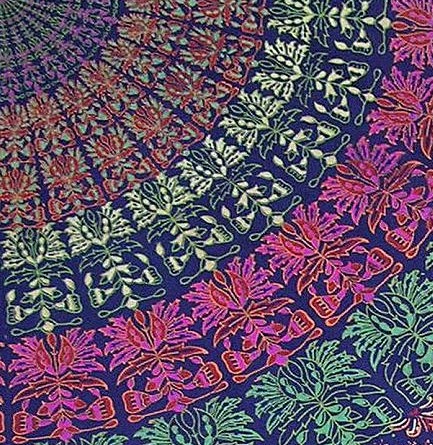
The blockcutter commences by carving out the wood around the heavier masses first, leaving the finer and more delicate work until the last so as to avoid any risk of injuring it during the cutting of the coarser parts. When large masses of color occur in a pattern, the corresponding parts on the block are usually cut in outline, the object being filled in between the outlines with felt, which not only absorbs the color better, but gives a much more even impression than it is possible to obtain with a large surface of wood. When finished, the block presents the appearance of flat relief carving, the design standing out like letterpress type.
Fine details are very difficult to cut in wood, and, even when successfully cut, wear down very rapidly or break off in printing. They are therefore almost invariably built up in strips of brass or copper, bent to shape and driven edgewise into the flat surface of the block. This method is known as coppering, and by its means many delicate little forms, such as stars, rosettes and fine spots can be printed, which would otherwise be quite impossible to produce by hand or machine block printing. Frequently, too, the process of coppering is used for the purpose of making a mold, from which an entire block can be made and duplicated as often as desired, by casting. In this case the metal strips are driven to a predetermined depth into the face of a piece of lime-wood cut across the grain, and, when the whole design is completed in this way, the block is placed, metal face downwards in a tray of molten type-metal or solder, which transmits sufficient heat to the inserted portions of the strips of copper to enable them to carbonize the wood immediately in contact with them and, at the same time, firmly attaches itself to the outstanding portions.
When cold a slight tap with a hammer on the back of the limewood block easily detaches the cake of the type-metal or alloy and along with it, of course, the strips of copper to which it is firmly soldered, leaving a matrix, or mold, in wood of the original design.
The casting is made in an alloy of low melting-point, anti, after cooling, is filed or ground until all its projections are of the same height and perfectly smooth, after which it is screwed on to a wooden support and is ready for printing. Similar molds are also made by burning out the lines of the pattern with a red-hot steel punch, capable of being raised or lowered at will, and under which the block is moved about by hand along the lines of the pattern. In addition to the engraved block, a printing table and color sieve are required. The table consists of a stout framework of wood or iron supporting a thick slab of stone varying in size according to the width of cloth to be printed. Over the stone table top a thick piece of woolen printers blanket is tightly stretched to supply the elasticity necessary to give the block every chance of making a good impression on the cloth.
At one end, the table is provided with a couple of iron brackets to carry the roll of cloth to be printed and, at the other, a series of guide rollers, extending to the ceiling, are arranged for the purpose of suspending and drying the newly printed goods. The color sieve consists of a tub (known as the swimming tub) half filled with starch paste, On the surface of which floats a frame covered at the bottom with a tightly stretched piece Of mackintosh or oiled calico. On this the color sieve proper, a frame similar to, the last but covered with fine woolen cloth, is placed, and forms when in position a sort of elastic color trough over the bottom of which the color is spread evenly with a brush.
The modus operandi of printing is as follows:
The printer commences by drawing a length of cloth, from the roll, over the table, and marks it with a piece of colored chalk arid a ruler to indicate where the first impression of the block is to be applied.
He then applies his block in two different directions to the color on the sieve and finally presses it firmly and steadily on the cloth, ensuring a good impression by striking it smartly on the back with a wooden mallet. The second impression is made in the same way, the printer taking care to see that it fits exactly to the first, a point which he can make sure of by means of the pins with which the blocks are provided at each corner and which are arranged in such a way that when those at the right side or at the top of the block fall upon those at the left side or the bottom of the previous impression the two printings join up exactly and continue the pattern without a break. Each succeeding impression is made in precisely the same manner until the length of cloth on the table is fully printed. When this is done it is wound over the drying rollers, thus bringing forward a fresh length to be treated similarly.
If the pattern contains several colors the cloth is usually first printed throughout with one, then dried, re-wound and printed with the second, the same operations being repeated until all the colors are printed.
Many modifications of block printing have been tried from time to time, but of these only two tobying and rainbowing are of any practical value. The object of tobey printing is to print the several colors of a multicolor pattern at one operation and for this purpose a block with the whole of the pattern cut upon it, and a specially constructed color sieve are employed.
The sieve consists of a thick block of wood, on one side of which a series of compartments are hollowed out, corresponding roughly in shape, size and position to the various objects cut on the block.
The tops of the dividing walls of these compartments are then coated with melted pitch, and a piece of fine woolen cloth is stretched over the whole and pressed well down on the pitch so as to adhere firmly to the top of each wall; finally a piece of string soaked in pitch is cemented over the woolen cloth along the lines of the dividing walls, and after boring a hole through the bottom of each compartment the sieve is ready for use. In operation each compartment is filled with its special color through a pipe connecting it with a color box situated at the side of the sieve and a little above it, so as to exert just sufficient pressure on the color to force it gently through the woolen cloth, but not enough to cause it to overflow its proper limits, formed by the pitch-soaked string boundary lines.
The block is then carefully pressed on the sieve, and, as the different parts of its pattern fall on different parts of the sieve, each takes up a certain color that it transfers to the cloth in the usual way. By this method of tobying from two to six colors may be printed at one operation, but it is obvious that it is only applicable to patterns where the different colored objects are placed at some little distance apart, and that, therefore, it is of but limited application.
Block printing by hand is a slow process~ it is, however, capable of yielding highly artistic results, some of which are unobtainable by any other means, and it is, therefore, still largely practiced for the highest class of work in certain styles.

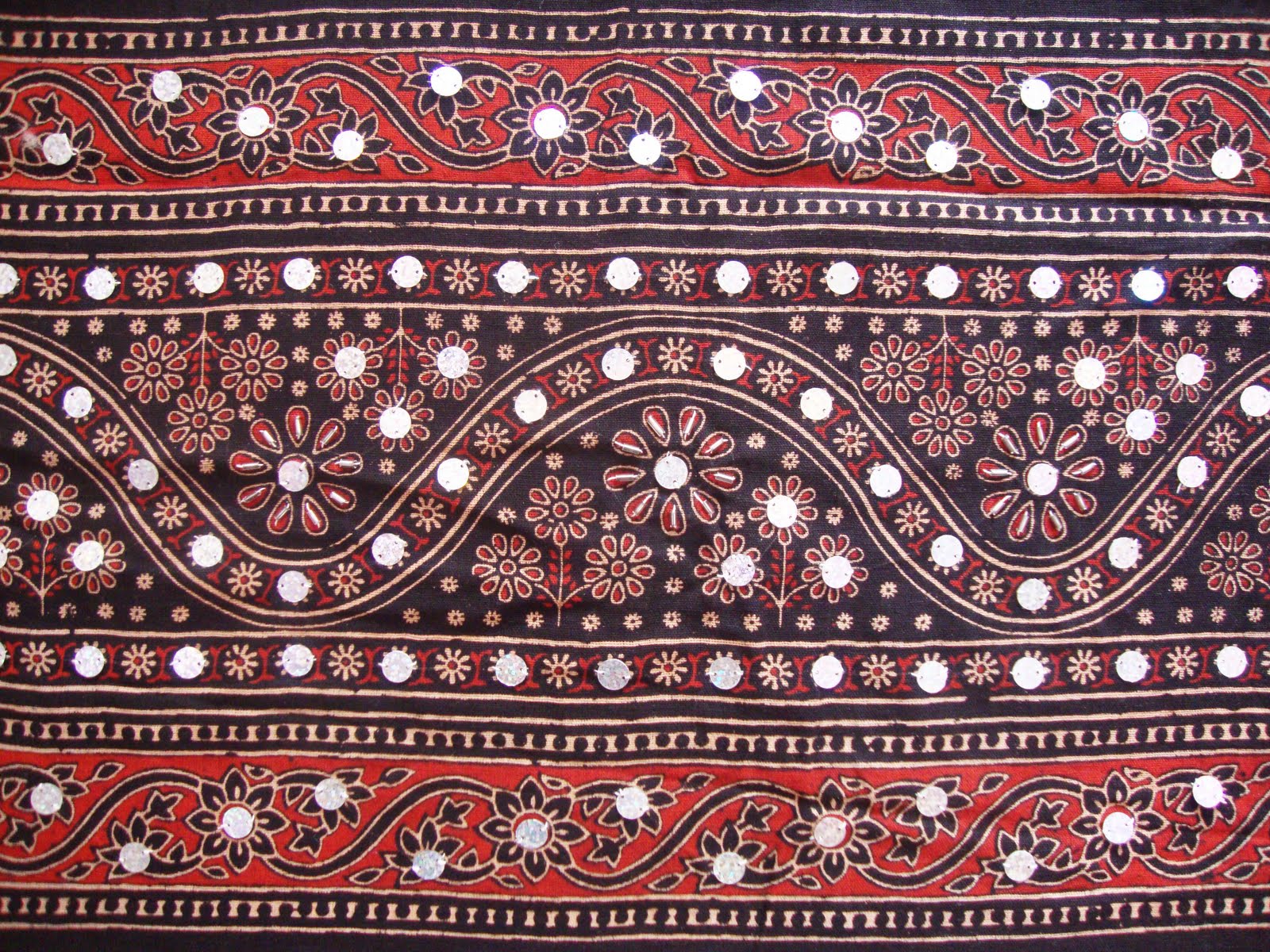
Select Your Next Chapter

Paithani
Paithani is a varient of Traditional Sari, named after the Paithan village in Aurangabad, Maharashtra state of India where these sari's where hand woven.

Kashmiri Shawls
Of the myriad varieties of textiles for which India was famous over much of Europe and Asia from at least the time of the Roman Empire, the Kashmir shawl stands out as the only woollen one.

Block printing
Records show that as far back as the 12th century, several centers in the south, on the western and eastern coasts of India became renowned for their excellent printed cotton.
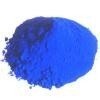
Natural Vedetable Dyes
The art of making natural dyes is one of the oldest known to human. In India, it was used for colouring fabric and other materials.

Durries
The weavers of the village of Salawas belong to the Prajapati caste. Although their main source of income was agriculture, they also practiced pottery and the weaving of jatpatti rugs.
Select Your Next Chapter

Sarees
'Jamdani' is a heritage handloom products of Bengal handloom. Word 'Jamdani' - derived from a "PERSION" word 'JAM' meaning a 'cup' and 'DANI' denotes the ‘container’.

Pichwai
India, wrapped in mystique, enhanced with the romance of fabled crafts, has one of the finest textile traditions in the world. Rajasthan is the home rather museum of paintings.
